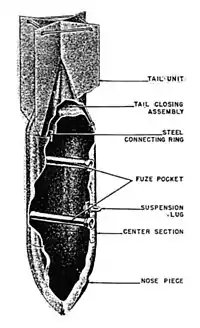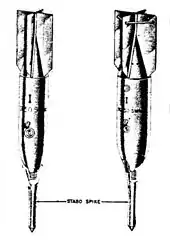SC 500 bomb
The SC 500 was a German Sprengbombe Cylindrisch ("cylindrical explosive bomb") was a family of 500 kg weight general-purpose bombs used by the Luftwaffe during World War II.
| SC 500 | |
|---|---|
 | |
| Type | General-purpose bomb |
| Place of origin | |
| Service history | |
| Used by | Luftwaffe |
| Wars | World War II |
| Production history | |
| Variants | K, L2, J |
| Specifications | |
| Mass | 500 kg (1,100 lb) |
| Length | 2.03 m (6 ft 8 in) |
| Diameter | 457 mm (18 in)[1] |
| Warhead | Amatol TNT Trialen |
| Warhead weight | 220 kg (490 lb)[1] |
Design

They had three-piece drawn steel bodies with a heavy machined nose cap for armor penetration. At the other end was a base plate, just forward of which the magnesium alloy tail was tack welded onto the body, and also bolted to the tail attachment brace. The bomb was usually filled with a mixture of 40% amatol and 60% Trotyl, but when used as an anti-shipping bomb it was filled with Trialen 105, a mixture of 15% hexogen, 70% Trotyl and 15% aluminium powder. Around the nose of the bomb was a kopfring - a metal ring, triangular in cross section, designed to prevent ground penetration or to stop forward momentum when hitting water. The bomb could also be fitted with a Stabo Spike which was an anti-ricochet device that prevented the bomb from burying itself too deep to increase its anti-personnel effectiveness. The bomb was attached to the aircraft horizontally by a H-type suspension lug. It could be horizontally suspended in a bomb bay or horizontally mounted on a wing or fuselage hardpoint.[1]
References
- "LUFTWAFFE RESOURCE CENTER". Warbirds Resource Group. 2018. Retrieved 27 February 2018.